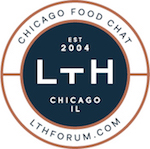Earthboxes, anyone?
Earthboxes, anyone?
-
-
-
-
-
-
Post #31 - May 26th, 2008, 8:32 amA quick earthbox question.
If for some reason you are direct sowing seeds in the earthbox,(in my case, im growing a couple varieties of bush beans) what do you do about the plastic cover ? Right now I cut a piece of plastic to protect the fertilizer strip and have left the area sown free. I plan to then thin the seedlings to the appropriate spacing and cover. Anyone have experience with this ?
-
-
Post #32 - May 26th, 2008, 3:07 pmI haven't used Earthboxes, but I've done other growing with plastic and fabric mulches. What I typically did was cut holes or narrow strips in the covering and plant my seeds there.
It sounds like it's too late for you to do that. Perhaps you might dispense with plastic covering and use a loose mulch instead.
-
-
Post #33 - May 27th, 2008, 6:44 pmWheattoast wrote:A quick earthbox question.
If for some reason you are direct sowing seeds in the earthbox,(in my case, im growing a couple varieties of bush beans) what do you do about the plastic cover ? Right now I cut a piece of plastic to protect the fertilizer strip and have left the area sown free. I plan to then thin the seedlings to the appropriate spacing and cover. Anyone have experience with this ?
I think the earthbox people would say to keep the plastic cover on at all times. Depending upon your specific crop, I've heard of people that cut the 5-8 holes on each side of the fert strip (I did this with my onions and the greens sprouted right through the holes without a problem) or cut long splits on each side and plant their lettuce and then thin out the plants once they sprout (this seems to be the preferred method for the larger earthbox commercial farms). I believe the bush beans have been planted using the second method with some success. I think it'll be hard to fit the caps over the boxes after the plants start.
-
-
Post #34 - May 28th, 2008, 1:08 pmThis weather is crazy but my earthboxes seem to be doing well overall. My tomatoes have finally started to grow, the broccoli is growing like mad, and the lettuce - well let's just say that I can't eat enough salad. On top of that, the zucchini is outgrowing the cukes in the same box (may have been a mistake to put them together) and my strawberries are small but good. Here are some updated pics:
Overall:
Tomatoes:
Broccoli:
Zucchini / Cucs:
Strawberries:
-
-
Post #35 - May 28th, 2008, 2:41 pmYou have red strawberries? Mine are decidedly green and tiny. However, I have lots of lettuce too, in fact I just gave some away to a passing LTHer. If nothing else, I'll end the summer with that success.Watch Sky Full of Bacon, the Chicago food HD podcast!
New episode: Soil, Corn, Cows and Cheese
Watch the Reader's James Beard Award-winning Key Ingredient here.
-
-
Post #36 - May 28th, 2008, 4:15 pmThey are red but they're small. They're getting bigger every week though. They still taste good. I have the ever-fruiting variety, which is supposed to fruit all summer but I've been told to trim the runners and pick most of the fruit and wait for the fall crop. The idea is that you should get your plants bigger before letting them fruit so their energy isn't wasted on little fruits and runners. I've been trimming runners and picking the fruit as soon as it's ripe (eating right off the vine - actually).
I feel the same way with the lettuce. Since this is my first year, I'm looking for small successes and learning from my mistakes. Good luck...
-
-
Post #37 - May 28th, 2008, 6:17 pmEarthboxes are a great product. You've done a great job on your rooftop!
My friends and I took it one step further and used commonly available materials to reproduce the same growing environment. We put about 50 of them full of all kinds of heirloom vegetables on our respective rooftops in the city of Chicago, and have been posting the results from the 2007 growing season to blogs hoping to get others to make these containers themselves. It's not a business proposition, we're giving "it" away, for several reasons. This is a food blog, so I won't bore you with the political speech(es). The short version is that it's the solution that food writer Michael Pollan comes up with in his essay "Why Bother?"
We put together a pretty comprehensive how-to guide at our Flickr page and at a handful of other places found by googling Flickr Rooftop Vegetables.
Here's one of the pictures I've been sending around.
http://www.flickr.com/photos/green_roof ... 652656573/
It doesn't look like the picture is going to show up here. I don't know enough BBCode to figure out what I'm doing wrong. If someone has any ideas on what to do, I'd be happy to try again.
-
-
Post #38 - May 28th, 2008, 6:23 pm
- Code: Select all
[img]http://farm3.static.flickr.com/2407/2171796643_5066dfcbab.jpg[/img]

-
-
Post #39 - May 28th, 2008, 6:37 pmBruce,
Welcome to the board. I've seen your pictures before and it's really one of the things that I mention when people think I'm crazy. It looks like you had a great "crop" last year.
I thought about the homemade boxes, especially since they're bigger and hold more water. Actually, I believe EB has a prototype that is a bit larger than the one they have now - most likely due to the homemade versions like yours.
I'm not affiliated with the EB company by any stretch of the imagination. I do think it is a good product but the idea can be replicated pretty easily. It's my understanding that, along with the time it takes to convert a rubbermaid-type of plastic bin to a self-watering container, the parts are actually around $10-12/each. That's not bad at all. The only con I've heard about is that the plastic tends to become brittle after a couple of seasons, whereas the EB plastic seems to last a little longer. My decision was purely based on time and space. It was bad enough that I had the EB's laying around the extra room for a couple of weeks, let alone having a small production line going on - although I seriously thought about it. For the record, I think I posted this earlier, my EBs were about $34 each, delivered.
Either way you go, I think it's a great way for us urban dwellers to participate in vegetable gardening. The principles and growing strategies are the same for both boxes or any similar boxes for that matter. Hopefully, you'll stick around and share your insights. Thanks for posting...
-
-
Post #40 - May 28th, 2008, 6:56 pmIt's a trade off, you're right.
We might have an answer to the UV problem. A plastic bag seems to be working, but it's only been 1 year.
We're close to figuring out an inexpensive automatic watering system for our boxes. Having to manually water each individual tub turned out to be more work than I expected. I'll let you know how the new system turns out.
I see that you live in Ukrainian Village. We, all 3 of us, are just north of you at Division and Wood. Nice to know other people are doing this too. Thanks for posting your pictures, and thanks to Ed Fisher/Gleam for getting my photo to appear.
-
-
-
Post #42 - May 29th, 2008, 9:16 amI'm in bucktown as well at Damen and Webster. =)
BruceF, I originally got my homemade EB info from your flickr page as well. I have been growing veggies for a couple years on my roof without earthboxes. They have done ok but I'm quite optimistic that this system will really work wonders up there.. Thanks for your posts and for your Flickr page, its one of the best resources I've found on the topic.
A quick question for you. With the current panic about PVC, have you found a source of pipe other than copper to use for the watering tube? Copper is about 80 bucks for an 8 foot pipe now! I've been looking for some bamboo but haven't found anything larger than 1" in dia.
Oh and Tyrus, your garden looks great !
-
-
Post #43 - May 29th, 2008, 11:47 amThanks - we're all in the same neighborhood. Maybe we should schedule a get-together for a beer and garden talk...
Here's some useful info on the PVC question that came up on another forum:
"""I figure if the PVC is good enough for potable water, then its ok for the vegetables as well. Make sure your pvc meets the following:
MATERIALS -
PVC materials used in Schedule 40 and Schedule 80 pipe
comply with the ASTM Standard D-1784 and
are a Type I Grade I compound. The raw material has only additives
that are approved by NSF International for potable water use to the
Standards 14/61 for Material Testing requirements."""
-
-
Post #44 - May 29th, 2008, 12:46 pmI learned quite a bit about plastics while doing this. I should say up front that I started out thinking, like the earlier comment "well, if it's good enough for potable water....."
I'm going to tell you why I changed my mind. I'd like to say that I don't think there's any way to talk about this stuff without sounding like a lunatic, especially to strangers. All I can say is go read the links and make up your own mind.
First was this story story published last fall in the Milwaukee Journal Sentinel (not a subscriber, found it online). They summarized it like this:A Journal Sentinel investigation found that the government has failed to regulate these chemicals, despite repeated promises to do so. The regulatory effort has been marked by wasted time, wasted money and influence from chemical manufacturers.
The newspaper reviewed more than 250 scientific studies written over the past 20 years; examined thousands of pages of regulatory documents and industry correspondence; and interviewed more than 100 scientists, physicians, and industry and government officials.
Among the findings:
• U.S. regulators promised a decade ago to screen more than 15,000 chemicals for their effects on the endocrine system. They've spent tens of millions of dollars on the testing program. As yet, not a single screen has been done.
• Dozens of chemicals the government wants to screen first have already been tested over and over, even while thousands of untested chemicals are waiting to be screened.
• By the time the government gets around to doing the testing, chances are the results will be outdated and inconclusive. The government's proposed tests lack new, more sensitive measures that would identify dangerous chemicals that older screens could miss.
• As the U.S. testing process remains grounded, hundreds of products have been banned in countries around the world. Children's products - including some baby toys and teething rings - outlawed as dangerous by the European Union, Japan and Canada, are available here without warning.
• Lacking any regulation in the U.S., it's impossible for consumers to know which products are made with the dangerous compounds. Many companies don't list chemicals known to disrupt the endocrine system on product labels.
The government's efforts have been "an abject failure, a disaster," said Philip Landrigan, a pediatrician and chairman of the department of community and preventive medicine at Mount Sinai School of Medicine in New York.
The reporter is starting to get some traction for her story in larger media outlets, CNN, PBS, etc. What I took away from it, at least as it relates to making earthboxes, is that the regulatory process is broken, and that any sign of doubt that actually makes it through a series of carefully designed media filters, should be heard as a scream. Experts agree that pvc is toxic to mfg, and to dispose of, that it's nasty when plasticizers are added to it (to make it more adaptable, e.g. i.v. drip bags, baby teething rings, but that it's "ok" in it's rigid form.
I'd also add this from the University of Pittsburgh's Center for Environmental Oncology:Are all plastics safe?
No.
You should avoid buying and using #3, #6, and #7.
#3 PVC (polyvinyl chloride, or vinyl):
PVC is hazardous in all of its phases: manufacturing, the products themselves in the home, and in the disposal of it.
One of the most toxic plastics, PVC is often used to make food packaging and in the production of plumbing and construction materials. PVC is commonly used in teethers and soft squeeze toys for young children, beach balls, bath toys (some rubber duckies), and dolls. Check the product or label to see what number plastic has been used.
To soften PVC into these flexible forms, various toxic chemicals are added as "plasticizers." Traces of these chemicals, known as adipates and phthalates, can leak out of PVC into your food. Some phthalates have been linked to cancer, kidney and liver damage, harm to developing reproductive organs, and premature breast development in baby girls. Inhaling these chemicals can also worsen asthma in children.
Because it contains a variety of additives and lacks a uniform composition, PVC is far less recyclable than other plastics.
Learn more about what makes up PVC: vinyl chloride.
Click here to learn about the alternatives to PVC that are available.
#6 PS (polystyrene):
#6 plastic may leach styrene into the food it touches. A recent study in Environmental Health Perspectives concluded that some styrene compounds leaching from food containers are estrogenic (meaning they can disrupt normal hormonal functioning).
Styrene is also considered a possible human carcinogen by the World Health Organization's International Agency for Research on Cancer.
#7 Other, most commonly PC (polycarbonate):
#7 polycarbonate may be able to release its primary building block, bisphenol A, another suspected hormone disruptor, into liquids and foods. Although several governments in Europe and North America currently hold polycarbonate tableware and food storage containers to be safe, this is a highly active area of research. Additionally, while category 7 most often refers to polycarbonate, it is actually a catchall "other" category, and it may not be possible to be sure just what it is. The Center for Environmental Oncology recommends avoiding these containers wherever possible.
So I've been avoiding #3, 6, and 7 whenever I can. I wouldn't call it a panic, more like pissed off. It's a huge hassle, but I don't want to be a guinea pig. I've only seen a couple of quotes in support of pvc (type #3). It's the medical establishment vs. the chemical industry. I'm following the MDs.
I first made the boxes with pvc, this year I took it out, replacing the screen supports with #1 PETE cups, and the fill tube with 1/2" poly (polyethylene) tubing. You can buy poly tubing stuff online from Lowes and they'll ship it free if you get more than $50 worth of stuff. Home Depot sells an adapter that screws on the end of a hose that fits inside the 1/2" fill tube or you can just put the fill tube inside the hose (but it leaks a little.) 1/2" copper pipe also fits inside the 1/2" poly, and you can tighten it with a snap tie. So my water supply is a little copper/a lot of polyethylene.
If anyone wants to get together and talk about any/all/none of this I'd be happy to. Or if you want to come over and check out what we're doing, let me know.
-
-
Post #45 - May 29th, 2008, 1:36 pmGood info. I like how much you've researched and adapted. I'm of the camp that says, "if you're going to do it - do it and then figure out how you can do it better." It's a constant learning process and much of the information isn't readily available. Just when you think you have something figured out, more info comes to light.
I for one, would be interested in grabbing a beer in the neighborhood in the next couple of weeks. Maybe we can all share our thoughts and questions. I'd also like to see your set-up.
Most evenings after work are good for me. Perhaps we can pick Smoke Daddy as a jump off point? Any interest?
-
-
Post #46 - May 29th, 2008, 3:42 pmno plumber here... but re "if it's good enough for potable water".. as far as i know, PVC is not up to code for potable water in most areas. i've seen it done in country houses and what not... but it's another reason why PEX and other things like that exist..
i'm jealous of those strawberries... ! we just installed a drip irrigation system on our roof, which i believe uses a black polyvinyl 1/4" tube... going that route instead. SO isn't convinced that underwatering is good for plants... i lost the argument. ... i still might do one as a trial experiment though.
... i still might do one as a trial experiment though.
another trivial consideration is PVC breaks down when exposed to ultraviolet light... i say moot because it's not likely to happen in the life span of an earthbox... (but if you have PVC vent pipes, they're reallly supposed to be painted with some/any paint to slow that down).
-
-
Post #47 - May 29th, 2008, 4:58 pmExcept for Wednesdays, I'm able to meet any weeknight after 5. Smoke Daddy works for me. We just need a time and date and we're set.
I might bring along my rooftop gardening friends, Art and Heidi, who live at Division and Leavitt.
-
-
Post #48 - May 30th, 2008, 8:03 amSounds good. How about Monday at 6pm? I'll be at the bar at Smoke Daddy if this is good. I'll check this thread out before I walk up there. Anyone else?
-Russ
-
-
Post #49 - May 30th, 2008, 9:41 amI'll try to make it too. I generally work till about 6:30 or 7, but will try to wrap it up early. Leaving early sounds good =)
-
-
Post #50 - May 30th, 2008, 1:23 pmIs it too late for me to plant an Earth Box with a tomato plant, 1-2 peppers and some herbs? It's been on my list of things to do this year but the weekends have gotten away from me and I finally have a free weekend day this Sunday. Any advice would be much appreciated.
-
-
Post #51 - May 30th, 2008, 2:16 pmI wouldn't think it's too late. In regards to the Earthbox - you may want to review the recommended planting schemes. Typically, only two tomato plants should be planted per box with a strip of fertilizer on the opposite side of the plants. So your tomato would be in one corner and maybe a pepper or some basil in the other corner. You may be able to get away with two pepper plants along with the tomato if you prune the tomato plant often.
Either way, it's not too late...
-
-
Post #52 - May 30th, 2008, 2:23 pm6 pm Monday at Smoke Daddy it is. I'm looking forward to meeting some other local container growers.
To Hellodali - I'd say it's not too late at all. Assuming we're talking about planting seedlings, not seeds (at least for tomatoes and peppers). As a matter of fact I held off on planting the eggplant and peppers I started from seeds because it's been so cold, overnight lows in the 40's. It seemed like every time I'd get set to put them in, the weather forecast just kept saying "cold". So I waited. They'll go in tomorrow.
In between preview and post, Tyrus beat me to it.
-
-
Post #53 - May 30th, 2008, 2:57 pmThank you Tyrus and Bruce. When I first inquired about them at Gethsemane, the staff there said I should be able to get in a tomato plant 1-2 pepper plants and some herbs. I'm glad it's not too late!
-
-
Post #54 - June 1st, 2008, 8:00 pmOne month in (more accurately - 28 days) and things are starting to warm up. Since we've had a few days above 70 degrees, things are starting to take off. Updates:
Overall:
Broccoli:
First signs of a broccoli crown: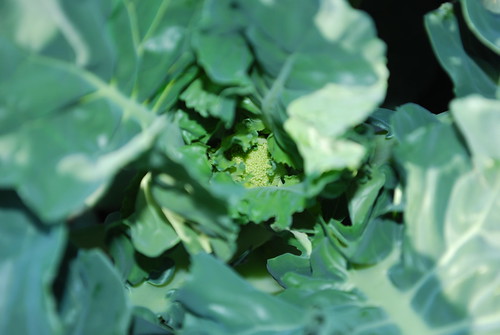
Zucchini: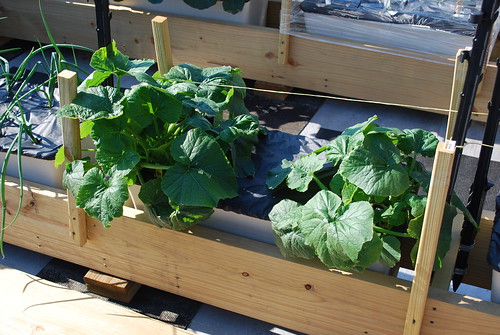
I'll be at Smoke Daddy at 6pm on Monday. See you there...
-
-
Post #55 - June 2nd, 2008, 10:11 amCan't make it to smoke daddy tonight unfortunately - Have fun! Hope to catch up with you folks next time.
-
-
Post #56 - June 2nd, 2008, 11:02 amBruce F wrote:6 pm Monday at Smoke Daddy it is. I'm looking forward to meeting some other local container growers.
Is this something that can be (should be?) posted on the Events Board?Last edited by The GP on June 2nd, 2008, 1:33 pm, edited 1 time in total.-Mary
-
-
Post #57 - June 2nd, 2008, 12:41 pmSorry, about that. I wasn't sure since it isn't a "formal" event. A couple of us wanted to get together to discuss container gardening and it just evolved in this thread. Since we're all local, it seemed to make sense. We probably should have used pm or something else...
-
-
Post #58 - June 2nd, 2008, 1:37 pmtyrus wrote:Sorry, about that. I wasn't sure since it isn't a "formal" event. A couple of us wanted to get together to discuss container gardening and it just evolved in this thread. Since we're all local, it seemed to make sense. We probably should have used pm or something else...
Tyrus -- no apologies needed. I was just asking. Many of the events that are posted aren't formal at all (e.g. Lunch tomorrow at <fill in the blank>!) and you might be able net a couple of other local LTH container gardeners. I watch the thread with envy not having the space to do the Earthboxes.-Mary
-
-
Post #59 - June 5th, 2008, 7:18 amWell, the rooftop container garden has taken off with the heat. My only concern is my lettuce; although I'm ready to replace it with something else at this point. I'm wondering with the warm weather this weekend if it's going to run it's course, so I thinned back each of the lettuce containers and "harvested the crop." The result was 5 one gallon bags of lettuce - romaine and red sail. Have no idea what to do with it, except eat salads for the next couple of days. Three days ago I did this same harvest and gave away three bags. Here's a picture of the washed lettuce.
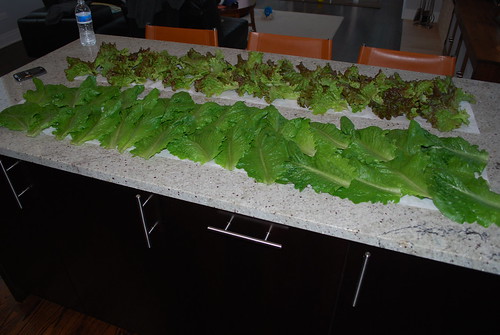
-
-
Post #60 - June 5th, 2008, 7:54 am
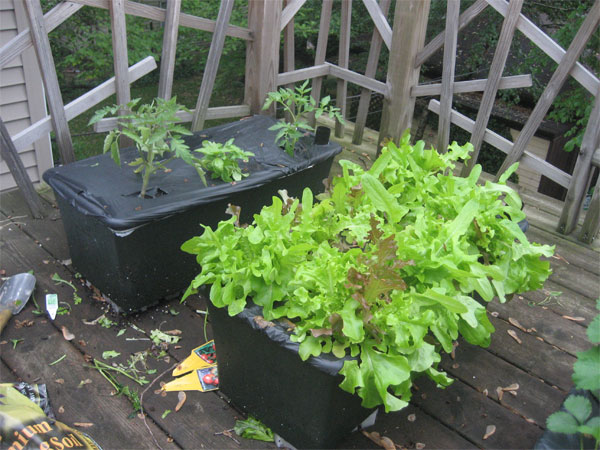
Well, obviously I need to tidy up a little, but here's the start of Phase 2 for me.
I envy your crop of neat, even-sized lettuce leaves in the picture above, Tyrus-- though not really, since we just picked when we liked and had wonderful fresh salads for a couple of weeks, giving away some of our bounty as well to passing LTHers (I think the only thing you can do, given the size of the crop in a short time, is share and bask in the compliments).
By last weekend the arugula in Box 1 had bolted-- it still tasted wonderful, but it was clearly getting stronger and heading into too-bitter-to-eat territory. The other lettuces around it were fine, but I did notice a fair number of wilted or at least somewhat limp leaves, maybe because there was just too much growing for everything to get sun. So as Box 2 (the mesclun blend, see original post) finally came into its own, and seems likely to give us excellent lettuce in quantities higher than we can probably eat for at least another week if not two, I made the executive decision to strip Box 1, with full gratitude for all we had enjoyed from it, and replant it with tomatoes.
Surprisingly, the easiest part was one of the things I had thought might be a disaster-- moving the fertilizer strip over to the far edge. With moisture it had solidified a bit and it was no trouble to move it in chunks. I planted two tomato plants and a genovese basil plant in between them, added a little tomato food to the fertilizer strip, and off we go.Watch Sky Full of Bacon, the Chicago food HD podcast!
New episode: Soil, Corn, Cows and Cheese
Watch the Reader's James Beard Award-winning Key Ingredient here.

